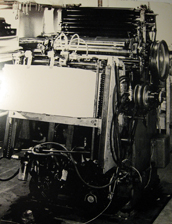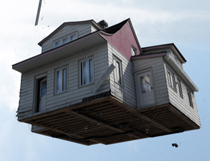Pages: 1 2
The Child is Father of the Pressman
Amatoritsero Ede in Conversation with Jamis Paulson
 Amatoritsero Ede: Turnstone began operations in 1978 to publish works by poets. Did poets establish it; necessarily you have diversified. How do you or have you sustained your initial focus on poetry?
Amatoritsero Ede: Turnstone began operations in 1978 to publish works by poets. Did poets establish it; necessarily you have diversified. How do you or have you sustained your initial focus on poetry?
Jamis Paulson: Robert Enright, John Beaver and Dennis Cooley started Turnstone Press to bring Manitoba poets to a larger audience. While they weren’t all poets, they all shared a common interest in seeing talented writers around them get published. Today, while we publish fiction and non-fiction as well as a genre imprint, we try to ensure that at least a quarter of our list is poetry. While many publishers have reduced their number of poetry titles or stopped publishing poetry altogether I find there is less uncertainty when committing to a print run for poetry compared to other genres. Poets are often very engaged in their writing communities so they often have a dedicated, albeit small audience. The predictability of sales along with increasingly affordable short print runs allows us to continue to publish poetry in Canada.
A.E.: Can we talk a bit about the role of the Canada Council for the arts here – not only in terms of the publishing of poetry but as far as support for Canadian publishing goes generally?
J.P.: Public funding across a variety of jurisdictions play a critical role in developing and maintaining professional publishing standards in Canada. A good portion of Canada’s independent publishing scene began with the commitment of talented “amateurs†who, while not knowing a lot about publishing, knew that creating books by Canadians was important and something they wanted to do. Of course desire and commitment doesn’t necessarily pay the bills, especially when it comes to poetry, and the financial support provided by these funding agencies allow poetry publishers and other small presses to retain salaried staff instead of relying on volunteer support and in turn thrive. Without their support of publishers and the numerous educational programs and organizations related to writing and publishing, Canadian publishing would not have the richness, diversity or level of regard it has today.
A.E.: What was or were your initial personal motivations for the art of book making – we can call it an art, can we not – what has sustained this interest over the years? I would definitely call book making an art.
J.P.: I grew up around books, my mom worked in a bindery while I was growing up and my first job was working for a small print shop running printing presses, folders, paper cutters and even doing layout and design by hand. I think my early exposure to the production of print has given me an understanding and appreciation for a well-made book. There is nothing quite like reading a book that puts the elements of paper choice, binding style, and graphic design together in a way that turns a great story into something sublime. Book making is also constantly evolving so there are new and exciting techniques to be used in book production in addition to the ever-changing electronic book market. Together the immense number of possibilities available for publishers and bookmakers makes the entire business exciting.
A.E.: It is too easily forgotten that printing is a technology – and I am not referring to the digital but that analogue printing which preceded it. In your experience would you agree with the first part of the last sentence?
J.P.: In publishing you can’t escape the fact that printing is technology. Whether digital or analogue, both forms of printing exist to produce texts in as quickly and as efficiently a manner as possible. Since the first printing press people have sought to refine and improve the printing process so that more books can be made for less expense. It may sometimes be easy to forget, especially in a perceived age of “paperless†publishing that the machines used to manufacture books are incredibly complex pieces of engineering and like all technologies they can be and have been improved upon.
A.E.: How much of analogue and/or digital technologies do you apply in your production processes and what informs this decision?
J.P.: Almost all of our pre-press work is done digitally and most of our first run books are printed from plates. The printer we choose to produce our books typically uses a direct to plate technology where the image is digitally burned onto the plating surface. When we have a short print run on a conventional paperback, ie. no ragged paper, etc., we have begun using digital printing technology. I still believe that the highest quality books are those that have ink absorbed into the fibres of the paper as opposed to an electrostatic transfer of an image to the surface of a page. Saying that, the quality of today’s digital printing equipment is certainly nearing that of offset printing and that is why we have started using it for our shorter print runs.
A.E.: What kind of printing press do you prefer for your presswork and is this decision affected by target print run?
J.P.: Most of our first run titles use an offset plate and ink press. Typically our paperbacks are printed on a web press and books requiring high detail colour will be run on a sheet-fed four colour offset press. As I explained before conventional format short run paperbacks are produced on digital printing technology.
A.E.: In this day of online bookstores do you still have to maintain warehouses, large or small? I am thinking of the mega virtual bookstore like Amazon, Barnes and Nobels and others.
J.P.: Even the mega virtual bookstores require their suppliers to engage a reliable method of fulfilling the orders they receive. Most only carry limited stock of each book they sell and in the case of backlist titles they sometimes do not carry any inventory at all. It would simply be impossible for them to keep stock on hand for every book that is published each year, not to mention books published in prior years. This is usually the reason a book may not be available for 3-4 weeks from an online reseller. They’re accounting for the time it takes them to make a request to a publisher or his/her warehouse and how long the book will arrive at their own warehouse. I think that as long as there are physical books to sell, a publisher will need to have a way to supply them to a bookstore, whether it’s online or not.
Pages: 1 2






No Comments so far ↓
There are no comments yet...Kick things off by filling out the form below.